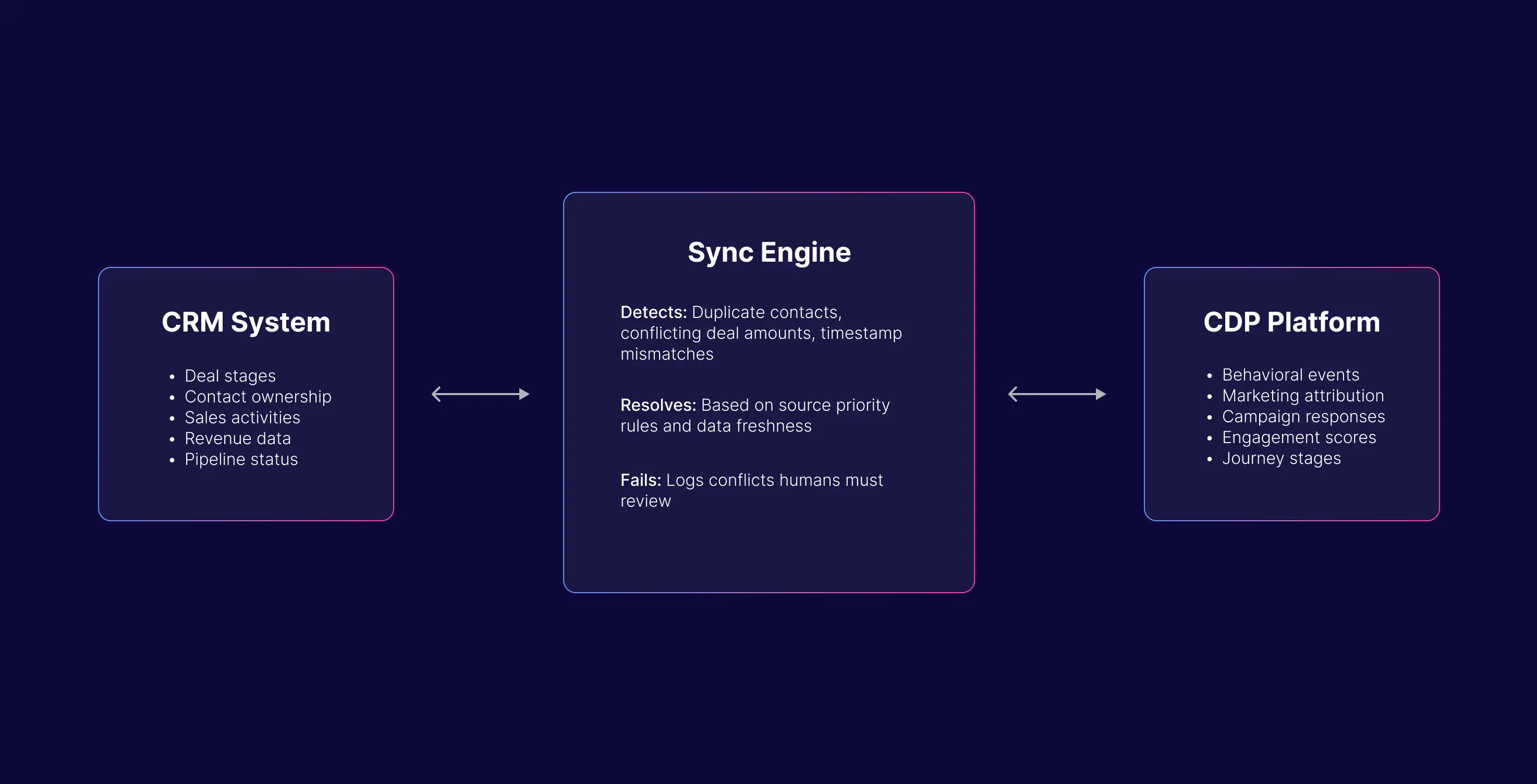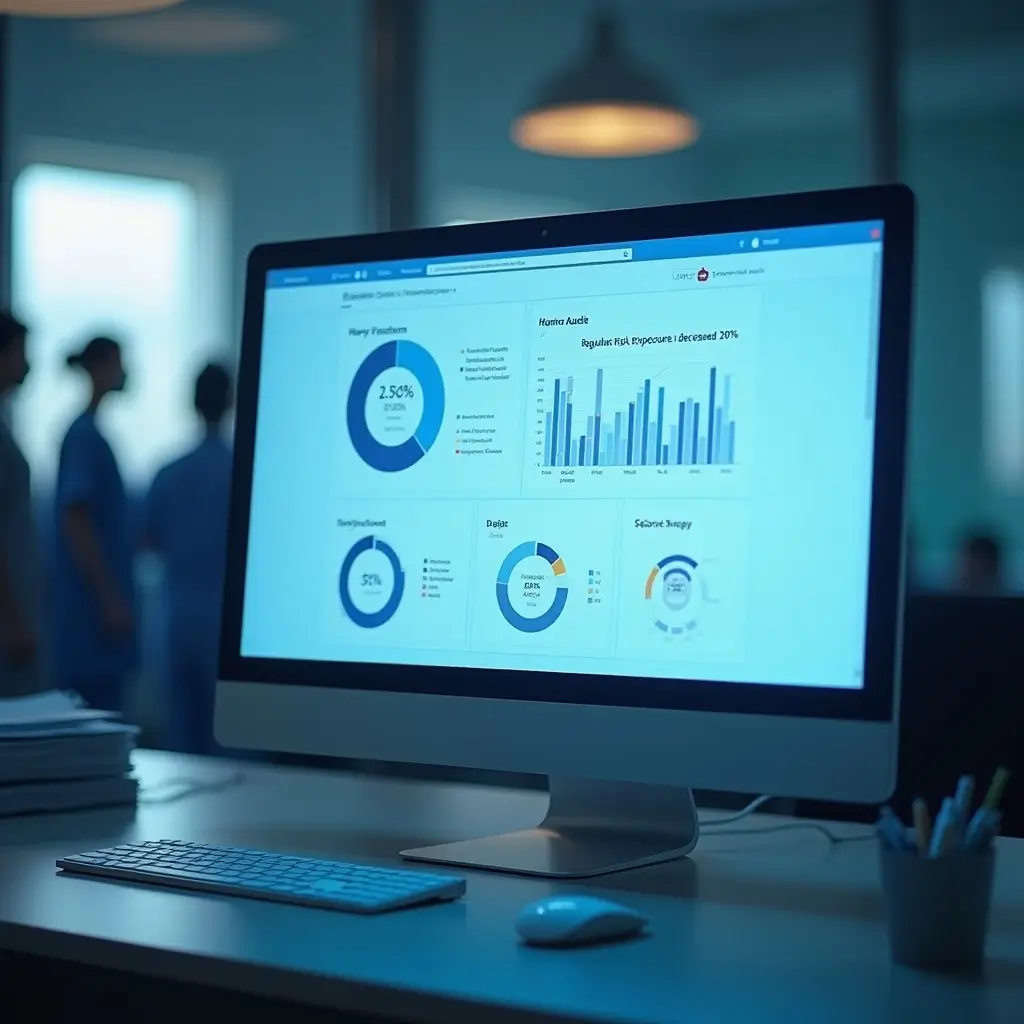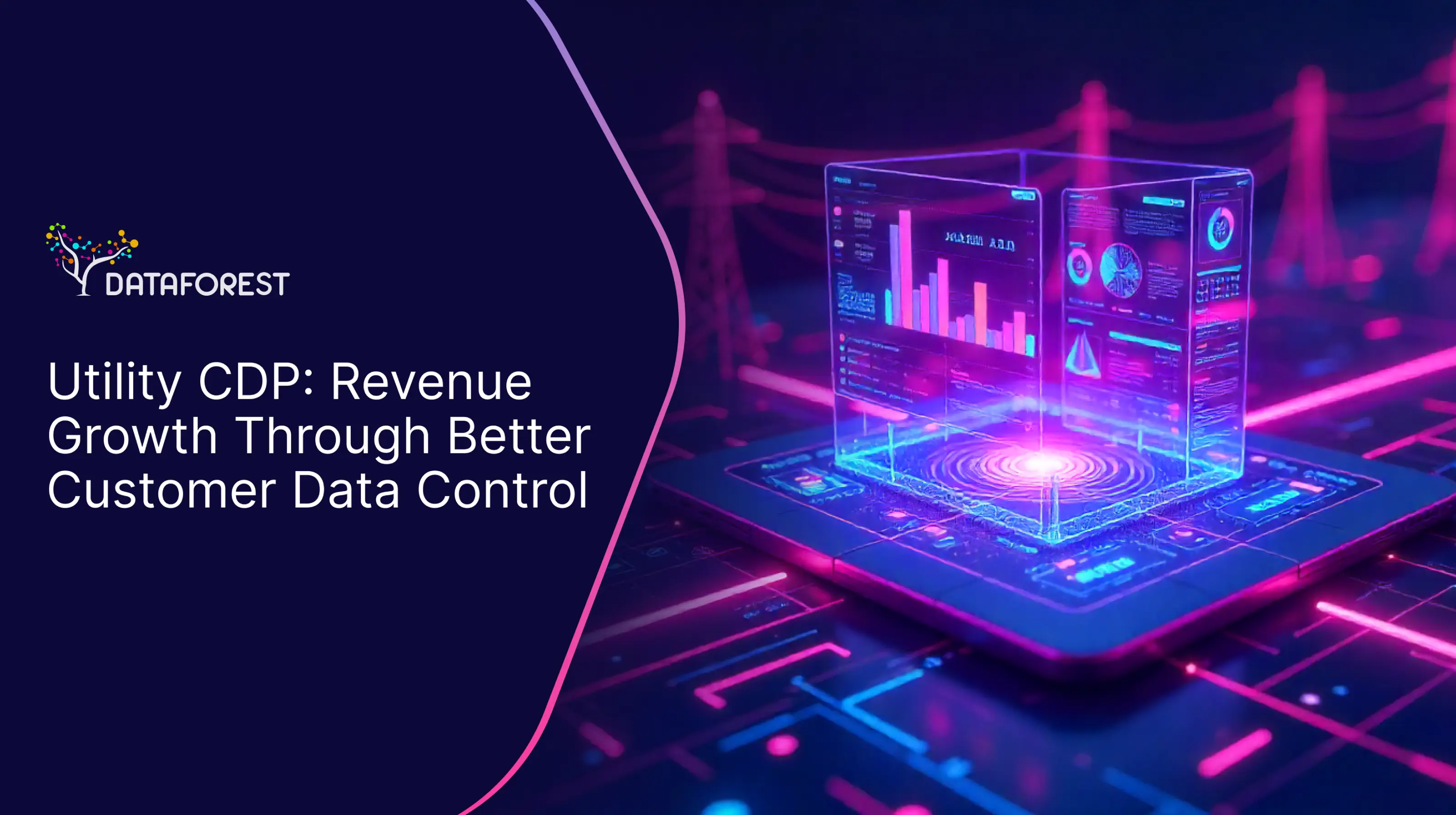Home page / CDP-CRM Data Integration
CDP-CRM Data Integration: Unified Customer Understanding
Unite customer information across sales, marketing, and service teams with the CDP-CRM sync solution. It enables personalized experiences to increase conversion rates, improve customer retention, and optimize marketing spend through better targeting. With over 18 years of data expertise, our solution enhances customer lifetime value, reduces acquisition costs, and fosters stronger customer relationships.




PARTNER

PARTNER
FEATURED IN

Unified CDP-CRM Sync for Revenue Growth
Stop losing revenue to fragmented customer data that creates decision paralysis, missed opportunities, and compliance risks across your sales and marketing teams. Our CDP integration with CRM automatically unifies conflicting records, enables seamless lead handoffs in real-time, and ensures regulatory compliance through AI-driven data synchronization.
Data Conflict Resolution
Marketing and sales teams lose confidence when CDP and CRM systems display contradictory customer information, resulting in delays in campaigns and pricing decisions. Our CDP integration with CRM automatically compares records in real-time and creates unified customer profiles with bidirectional sync, eliminating data contradictions and restoring team confidence through data reconciliation.
Real-Time Lead Sync
High-value leads generated in CDPs within CRM systems often fail to sync instantly to the CRM, causing sales reps to miss opportunities. Our real-time data integration with AI customer data management ensures that sales teams receive prioritized, decision-ready opportunities without delay, thereby eliminating revenue leakage caused by timing gaps and enabling data enrichment for enhanced lead quality.
Automated Data Reconciliation
Data analysts spend weeks manually merging customer records before campaigns, creating bottlenecks in time-sensitive initiatives. Our automated data sync solution utilizes business rule engines to resolve data conflicts between systems instantly, while flagging complex cases for human review to ensure data unification and improve data quality across platforms.
Compliance Governance
Data inconsistencies between CDP and CRM systems create audit trail gaps that violate GDPR requirements, exposing companies to fines of up to 4% of their global revenue. Our AI data integration solution automatically synchronizes consent status and data retention policies across platforms, leveraging master data management (MDM) for customer data harmonization and maintaining compliance.

Marketing says lead is hot, sales says—cold.
Resolve conflicts automatically.
Real Life Examples of the Customer Data Synchronization
CRM-CDP Sync—Control Data Chaos


CDP and CRM Sync Solution Details
Transform fragmented customer data into unified, real-time profiles with our AI-powered CDP-CRM integration. Prevent customer data silos and revenue leakage. Provide regulatory adherence through intelligent synchronization.

Real-Time Bidirectional Data Synchronization
Event-driven architecture ensures that customer data changes sync across systems in under 100 milliseconds with zero data loss.
- Event-driven architecture processes changes in under 100ms with automatic failover protection for CDP-CRM sync
- Change data capture mechanisms to ensure no updates are lost during high-volume periods
- Batching optimizes sync speed while preserving real-time capabilities for updates in the CDP-CRM sync

AI Data Conflict Resolution
Machine learning models automatically resolve 95% of customer data conflicts in CDP-CRM sync with intelligent escalation for complex cases.
- Different resolution processes adapt to conflict types like contact info vs behavioral data
- Confidence scoring determines when multi-field conflicts need human review through the CDP-CRM sync
- System improves accuracy by analyzing resolution outcomes and user feedback

Universal Customer Identity Management
Unified customer profiles maintain persistent identities across all systems with real-time capabilities.
- Probabilistic and deterministic algorithms create unified profiles across CDP-CRM sync
- Cross-platform graphs maintain customer IDs even when contact information changes
- Consolidated profiles contain accurate and complete information from CDP-CRM sources
.svg)
Data Quality and Validation Framework
Real-time validation and standardization ensure the high-quality collection of customer data across all integrated CDP-CRM systems.
- Automated rules check data quality as it enters either system, with instant feedback
- Engines normalize addresses, phone numbers, and names across different requirements in the CDP-CRM sync
- Scoring provides reliability metrics for each profile field and overall record health

Intelligent Duplicate Detection & Merging
ML-based detection identifies and merges duplicate customers while preserving historical data.
- ML similarity scoring identifies duplicate customers with 98% accuracy across formats in the CDP-CRM sync
- Automated workflows consolidate duplicates while preserving all historical interaction data
- Restore previous customer states if merging operations require correction, and the CDP-CRM sync
.svg)
Compliance & Audit Management System
GDPR-compliant processing with automated workflows ensures consistent regulatory adherence with CDP-CRM sync.
- Automated processing ensures consent status synchronizes across CDP and CRM platforms
- Workflows handle deletion requests and retention policies across CDP-CRM sync
- Comprehensive logs capture every operation with automated regulatory reporting tools

One version of revenue truth.
Eliminate variance between board and management metrics.
Key Steps to Creating a Customer Data Platform and CDP Synchronization

Step 1: Find Where Bad Data Decreases Revenue
Map conflicts that cost money. Skip theoretical problems. Focus on deals lost, time wasted, decisions broken by sync failures.
01

Step 2: Build Rollback Before Sync
Create a fast path back to the old system. Sync projects fail spectacularly. Teams need a trusted escape route.
02

Step 3: Set Conflict Resolution Rules
Decide which system wins each fight. Base choices on financial impact. Sales beats marketing for deal status. Finance beats everyone for customer billing.
03

Step 4: Start Simple, Scale Later
Move clean records first. Handle obvious duplicates. Skip edge cases until basic flow works with production volumes.
04

Step 5: Add Gradual Conflict Detection
Detect disagreements between systems. Log them without fixing anything yet. Teams need to see the mess before they trust the fixes.
05

Step 6: Test at Real Scale
Use production data volumes, not samples. Systems that sync 1,000 records break at 100,000. Test network failures and database crashes.
06

Step 7: Deploy with Intensive Monitoring
The first month requires constant attention—budget for weekend fixes and emergency calls. Sync failures cascade through everything downstream.
07
FAQ on Customer Data Platform and CRM Integration
Does DATAFOREST automatically remove duplicate customer records across CDP and CRM?
DATAFOREST includes built-in deduplication and record matching logic to unify customer profiles across connected systems in CDP-CRM sync. We continuously monitor for duplicate or nearly duplicate records and apply matching rules to merge or link them during CDP-CRM sync processes. In workflows where ambiguity persists, it can flag records for human review rather than blindly merging them, ensuring accurate CDP-CRM sync outcomes.
Can DATAFOREST integrate with multiple CRM and CDP platforms simultaneously?
Our architecture enables seamless integration with numerous CRM and CDP systems simultaneously, utilizing connectors and APIs for cross-platform data synchronization and a bidirectional CDP-CRM solution. It acts as a central hub, funneling data across platforms while enforcing customer data consistency in CDP-CRM sync. You can onboard new systems gradually without disrupting existing CDP-CRM sync integrations.
How fast does DATAFOREST synchronize data between systems?
We support real-time or near-real-time CDP-CRM synchronization via streaming or event-driven architectures (as opposed to only batch transfers). In practice, updates generally propagate within seconds to minutes, depending on system latency and load during CDP-CRM sync. The speed of CDP-CRM sync is adjustable depending on the criticality of business processes.
Can conflict resolution rules be tailored to meet industry-specific needs?
You can define custom resolution rules tailored to domain logic (for example, preferring one system's value under certain conditions) for CDP-CRM sync. DATAFOREST enables you to layer default and override rules, allowing industry constraints to be enforced during CDP-CRM sync. Cloud-based CDP-CRM sync solutions can escalate ambiguous cases for manual review when rules can't fully resolve them.
Does DATAFOREST ensure GDPR, HIPAA, and industry compliance?
Our data governance framework incorporates encryption, authentication, authorization, and traceability to support GDPR, HIPAA, and other regulatory regimes in CDP-CRM sync. It also implements consent tracking, audit trails, and role-based access control to enforce compliance with industry privacy standards during CDP-CRM sync. Compliance practices for CDP-CRM sync can be adapted to new regulations as they appear.
What happens if one of the connected systems goes offline?
If a system becomes unavailable, DATAFOREST buffers changes and queues them for later replay when the system becomes available again, ensuring reliable CDP-CRM sync. It isolates failures so that other system integrations can continue uninterrupted during the CDP-CRM sync. Error alerts and retry mechanisms ensure data consistency once connectivity is restored for CDP-CRM sync.
Can DATAFOREST adapt conflict resolution rules to specific business needs?
The rules engine is configurable, allowing you to encode business priorities and override default logic as needed for CDP-CRM synchronization. You can version and evolve these rules over time as your business policies change in CDP-CRM sync processes. During pilot phases, you can simulate or test new rules in "dry run" mode before putting them into production for CDP-CRM sync.
How does DATAFOREST monitor and validate data quality in real time?
We continuously apply anomaly detection, validation checks, and profiling metrics to incoming and synchronized data in CDP-CRM sync. Outliers or inconsistencies are flagged, and dashboards display data health metrics, allowing you to intervene during CDP-CRM sync. You can also set thresholds for alerting when data quality drifts in CDP-CRM sync operations.
Does DATAFOREST integrate with existing BI and reporting tools?
We expose unified, cleaned datasets via APIs, data warehouses, or export connectors, which BI tools can consume as part of CDP-CRM sync. The cleaned, canonical customer views from DATAFOREST serve as a trusted source for analytics and reporting in CDP-CRM sync. That way, your dashboards and reports always draw from the synchronized, high-quality data layer produced by CDP-CRM sync.
Can DATAFOREST handle millions of customer records without performance issues?
The architecture is designed for high volume and scalability using modern data engineering patterns (streaming, partitioning, distributed processing) for CDP-CRM sync. You can scale horizontally to support growing data volumes, and performance is maintained through indexing, caching, and efficient change detection in CDP-CRM sync. This ensures stable performance even during peak loads for CDP-CRM sync.
Let’s discuss your project
Share project details, like scope or challenges. We'll review and follow up with next steps.


.svg)








.svg)
.svg)
.svg)

.svg)
.svg)
.svg)







.svg)






















